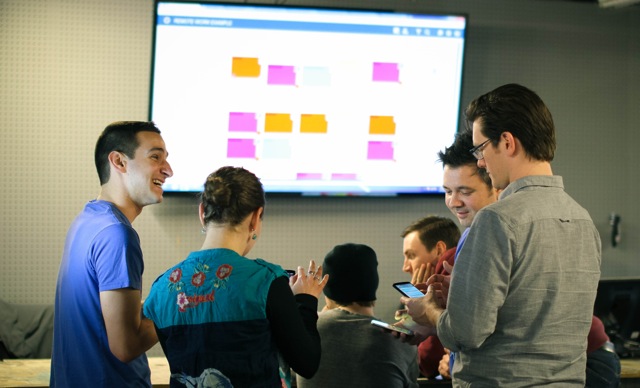
Step three of The Kanban Roadmap: How to Get Started in 5 Steps
As a systems-thinking methodology, Kanban calls for team members to take collective responsibility for team priorities. Rich conversations about the work are a must-have. They help the team discover bottlenecks, resolve issues, focus on flow, and continuously improve their process. To facilitate these discussions, teams often adopt standups and retrospectives.
- Standups receive their name because teams meet while standing, rather than sitting, when gathered around their Kanban board. Standing encourages brevity and staying on task.
- Retrospectives are held on a regular basis, whether weekly, bimonthly, or monthly. They give the team a focused opportunity to evaluate the health of the system, make adjustments, and devise experiments.
When implemented effectively, standups and retrospectives are powerful tools for teams that seek transparency and open collaboration. Without targeted discussion, however, standups can morph into what’s-on-my-schedule recitations, and retrospectives can turn into personnel critiques. The next two activities will help keep your team focused on the work and the process, while laying the groundwork for a team culture of continuous improvement.
Focus on Flow During Your Kanban Standup
For optimal efficiency, team members should update the status of their work items prior to standup, so everyone sees a current picture of the work in process.
Each day, a different team member leads the discussion. The leader begins by “walking the board” from right to left — to focus first on work items that are closest to completion — and asks of those cards, “What do we need to do to advance this piece of work?”
Always favor finishing something over starting something new. When the team views the entire system as belonging to them, then the most important outcome is for the team/system to get something all the way to “done.” So when the leader asks, “What do we need to do to complete this piece of work?”, and a person assigned to the work answers, “I just need a little help today to push it over the line,” a team that’s working as one system won’t be short of volunteers.
After walking the board, ask the team:
Q: “Is anyone working on anything that’s not on the board?”
A: If no, continue to the next question. If yes, pause to let team members add work items.
Why: To gain the truest possible understanding of the team’s workload.
Q: “What are we looking to finish, as a team?”
A: Look at business value, encroaching deadlines or your team’s chosen unit of value to reprioritize or reassign work, as needed.
Why: To reinforce that all work is the team’s work and to help move prioritized work over the goalline first.
Q: “Can we spot any bottlenecks or other impediments to the flow of work?”
A: Look for queues of work, loaded lanes or other indicators of risks and issues.
Why: To observe both the upstream and downstream ramifications of stalled flow and to figure out how to get work flowing again.
Whether or not you’re new to standups, it’s likely that you’ll notice discrepancies in the granularity of work items (particularly within the first month of asking these questions). Continue to divide work into smaller tasks and subtasks, as necessary. Look to have your cards represent not only the units of value that your team is expected to deliver but also your capacity to deliver them.
The finest of fine-grained tasks may not need to be separate cards on the board. If you use physical Kanban boards, you can attach them to the main card as to-do lists or subtasks; or, if you’re using Planview AgilePlace, you can use taskboards. Work items should be small enough to move across the board at a relatively uniform pace.
Finally, evaluate the physical environment of your standup and its potential challenges. For example, if the entire team is so crowded around a laptop that everyone can’t see the board, you may want to consider one of these five recommended hardware configurations to improve visibility and transparency.
Analyze Work During Your Kanban Retrospective
At the end of every week, gather around the board to evaluate your Kanban system. Observe the flow of work and add a new question each week.
By week four, you’ll be asking four questions.
WEEK 1Q: Is there any hidden work in process (WIP) that we haven’t gotten onto the board yet?
A: Searching for hidden WIP will be an ongoing theme for your first few weeks. It’s not always evident and can take time to reveal itself. As you find it, add it to the board. (Stop here if in week one; otherwise, continue.)
WEEK 2Q: Can we identify any impediments to the flow of work?
A: Look at where work is piling up on the board, where work is getting blocked, or parts of the workflow that may be “starved” for something to work on. Discuss ways in which the process or the team’s policies could be modified to remove impediments to flow. Even after you finish these exercises, ask this question during every retrospective. (Stop here if in week two; otherwise, continue.)
WEEK 3Q: Are we tracking things at the right level of granularity?
A: If some of the work items are so big that they’ll take months to move across the board, break them down into cards you can complete in a few days or weeks. If your board is littered with very small tasks, consider using task lists associated with the card instead of a card for every small task that must be done in a day. (Stop here if in week three; otherwise, continue.)
WEEK 4Q: A queue or buffer happens when work is in a holding pattern before it goes to the next step. Are there queues or buffers in your workflow that aren’t represented on the board?
A: If yes, add lanes into your process to represent these queues. Managing the size of queues in your kanban system is a key success factor to improving the flow of work. Identifying queues will be an ongoing activity, even after you’ve completed the exercises in this guide.
Pay special attention to the start and end states. Where does the work for this team originate? What is the source of demand?
If you find that you have two teams working towards separate goals, and those teams’ work rarely intersects, you may have more than one process. Try to reserve one board for each process or add a swimlane to the team board to show there are parallel processes at work.
The Bottom Line
Kanban is about seeing your work as a system, rather than a collection of individual tasks. Effective standups and retrospectives empower team members and managers alike to observe flow, resolve issues, and run experiments, helping everyone stay more engaged and support a culture of continuous improvement.
Looking for more ways to engage your team in Kanban essentials?The Kanban Roadmap: How to Get Started in 5 Steps includes real-world scenarios and team-based activities (including the one in this blog post) to help your team achieve a sustainable Kanban system. Get the eBook for your team today.
![A Global Collaborative Work Management Blueprint [Video]](https://blog.planview.com/wp-content/uploads/2019/07/A-Global-Collaborative-Work-management-blueprint.png)



